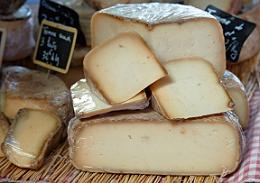The Top French Cheeses
Among all the excellent food France has, it generally counts on cheese by region:
Camembert: made in Normandy in the little village of Camembert. This cheese is from soft cows’ milk with a furry white rind speckled with pale interior which becomes increasingly yellow when the cheese matures. The best examples are usually made from raw milk, but today most mass-produced Camemberts are pasteurised. When it is fully ripe, Camembert has a pungent, strongly-flavoured and runny interior somewhat similar to the Brie, except Brie is produced in large flat wheels.
Crottin de Chavignol: is among the most popular cheeses in France. This cheese is made from raw goat’s milk in the small town of Chavignol, near the town of Sancerre in Pays-De-La-Loire. You should look for one of the best producers, which will have the word “Fermier” (farmstead) on the label. When it is not too young, the interior is white; and when it is not too old, there is a dark brown exterior. The cheese is typically aged from 3-4 weeks, up to 4 months, so you can pick one with a beige exterior, which means it is aged about 2 months.
Brie de Meaux: produced in the Île de France region near Paris, already existed during the time of Charlemagne in the 8th century. By 1815, it had become truly famous when Talleyrand designated it as the “King of Cheeses.” Other cheeses have also been called King of Cheeses including Roquefort and English Farmhouse Cheddar, for example.
Roquefort: the Americans call the French the “smelly cheeses” because of the strong smell of the Roquefort. This cheese comes from the ewe’s milk, the processing of the curd, the “penicillium roqueforti” and then the maturation in natural caves. The mold Penicillium roqueforti was found in the same caves where the cheeses aged. Today, the mold is mostly produced in laboratories to ensure its consistency.
Reblochon: a rich soft pressed cheese made in the French Alps; it has quite a strong flavour, and a creamy texture. It is a typical Savoie cheese in the French Alps to warm the body and soul. The name Tartiflette comes from the Savoy word for potato and the Reblochon is an integrant part of it. You can substitute the milder Gruyere cheese if you need.
Cantal: one of the oldest cheeses in France, even before Roquefort and Livarot. It was first mentioned during the 1st Century AC. Cantal cheese is named after the Cantal Mountains in Auvergne, where the cheese comes from. Cantal is also the name of a French department. Cantal is made from pasteurized cow’s milk and is ready after aging for at least one month for a young cheese. For an old cheese it should age 6 months.
Pont l’Évêque: is a washed-rind cow’s milk cheese made in Normandy. Legend says that Pont l’Evêque was introduced by monks in the Pays d’Auge during the Middle Age; it was known by its current place-name by the seventeenth century. With its mild, milky, and grassy flavours, Pont l’Evêque is an excellent example of the very high quality of French cheeses. We invite you to taste Pont l’Évêque with Champagne as it is absolutely excellent. One piece weighs approximately 8.5 ounces.
Comté: this delicious French cousin of the Gruyère is made from the region of Franche Comté, eastern France. The production area stretches along the Swiss border, and all milk comes from cows grazing at least at a 400-metre altitude. This cooked cheese is manufactured collectively village by village, and the production method has not changed a lot the last centuries.
Do you know any other French cheese you liked which is not listed above?


